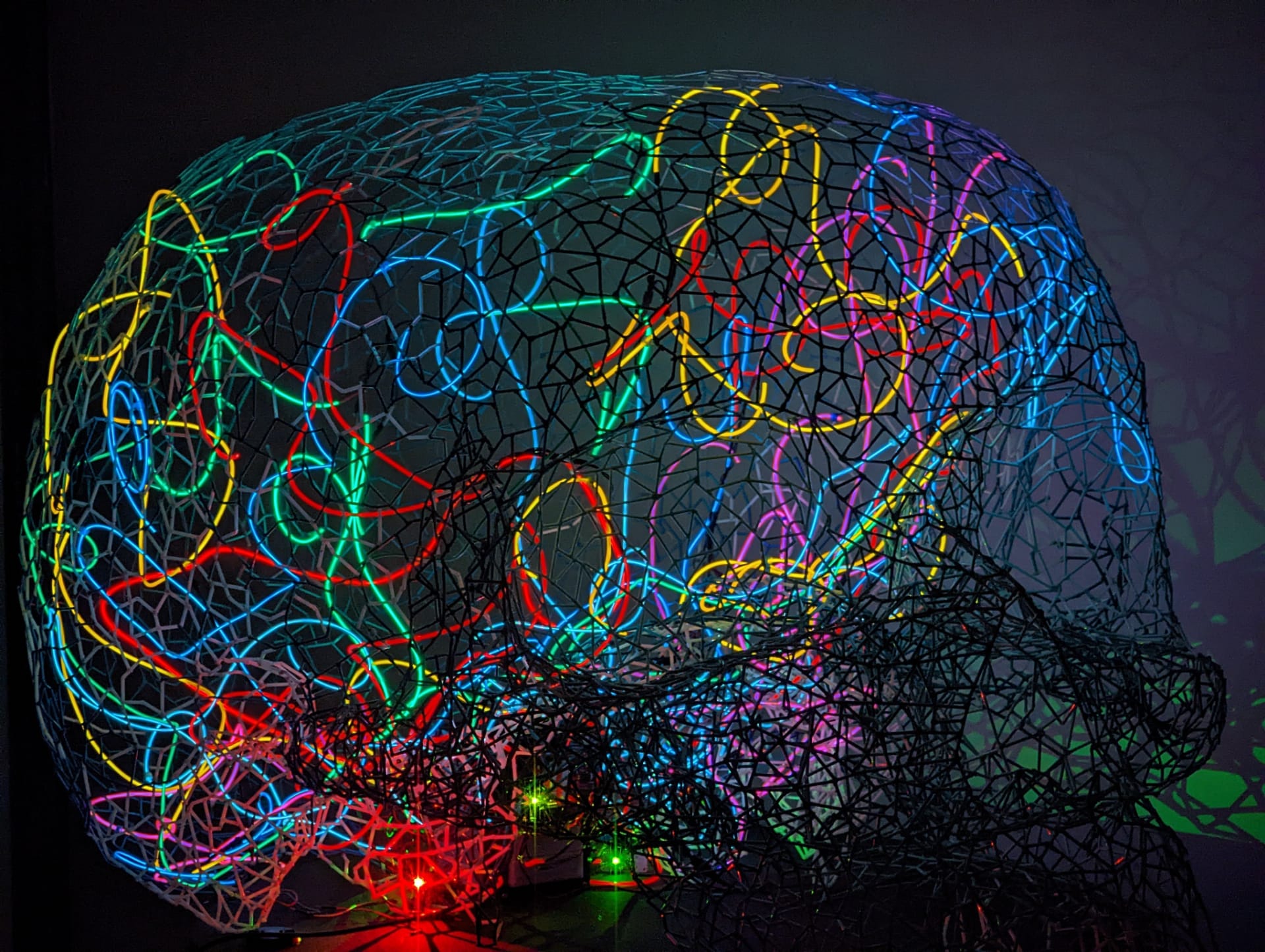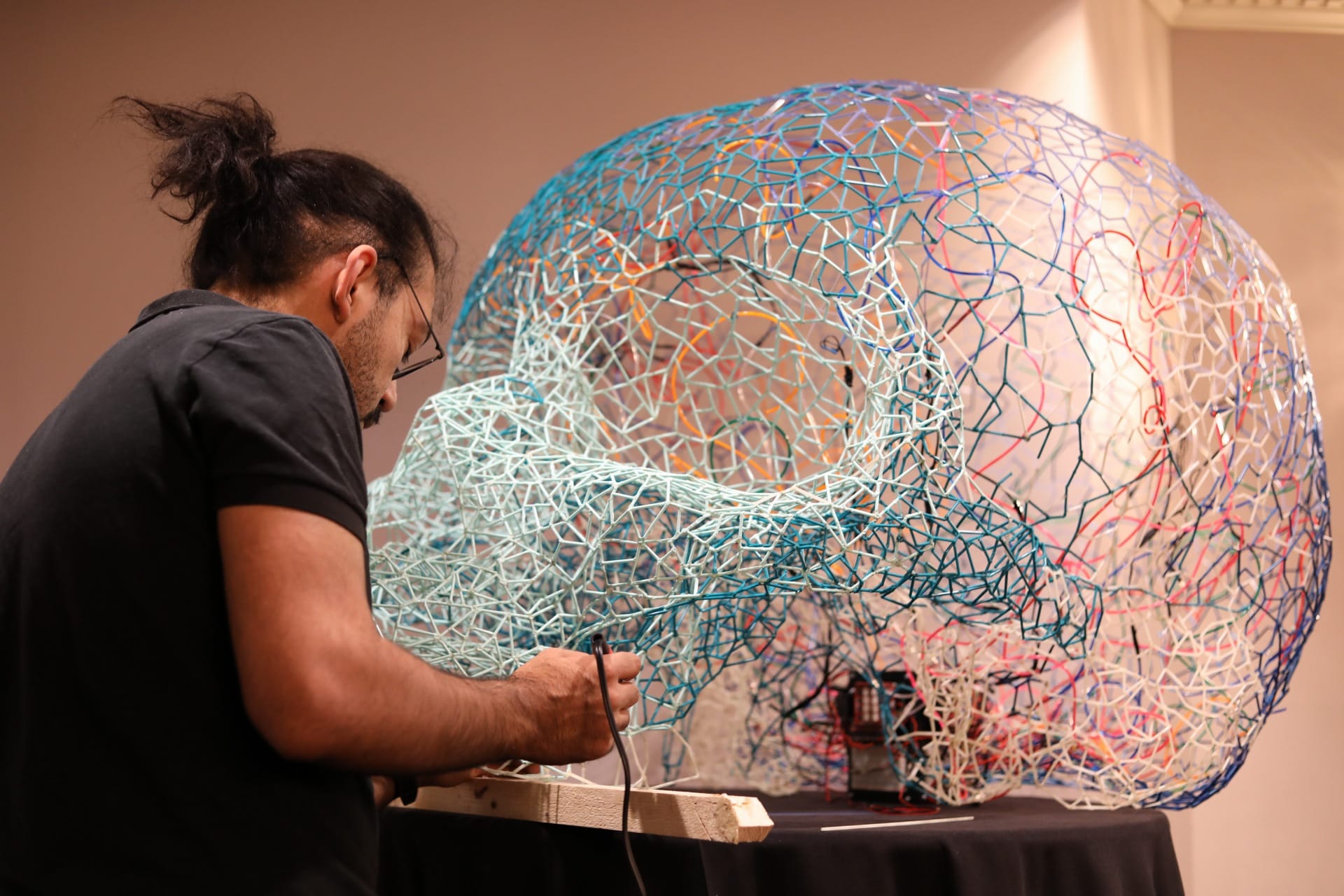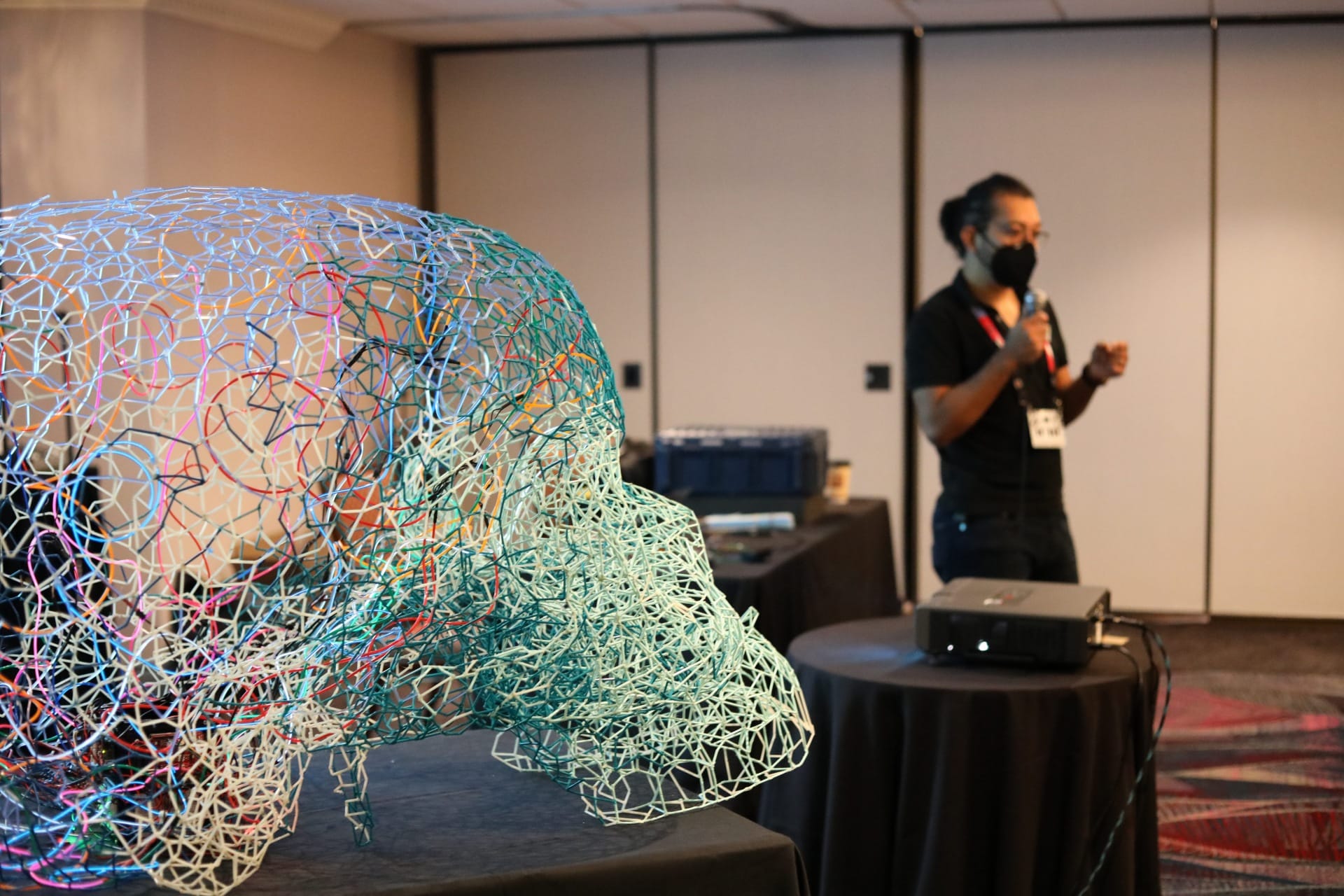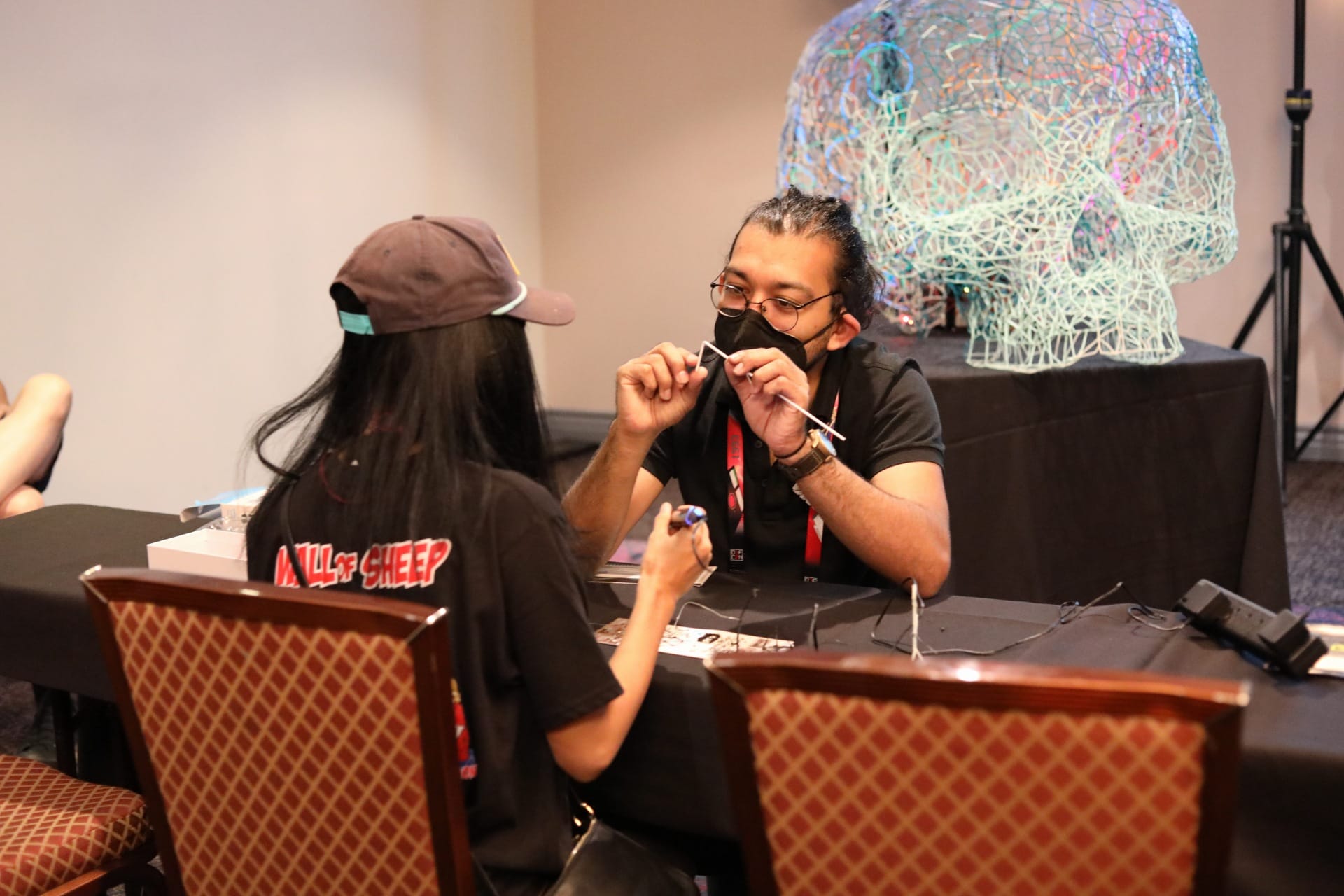At the 2022 DefCon security conference in Las Vegas, Mexican artist Ricardo Martínez presented a new 3D printed sculpture described as “a connected light installation on cerebral (dys)function.” Dubbed Memento Vivere, the light installation comprises several connected objects interacting with spectators as they pass through the exhibition space.
Aiming to give viewers an experience at the intersection of art and technology, the multidisciplinary installation c series of electroluminescent cables emerge from a skull structure built with the 3D pen, 3Doodler. The cables together form massive connected objects which respond to the interactions of their participants, as different cables and sectors of the installation will light up according to the movement in front of the piece, the acoustic vibration, temperature, the electronic objects present in the room, and so much more. Thus, spectators are encouraged to move around and walk in front of the sculpture, to discover the actions that stimulate the brain.
 Memento Vivere sculpture by Ricardo Martinez for DefCon lights up.
Memento Vivere sculpture by Ricardo Martinez for DefCon lights up.Developed in Brussels, Belgium, where Martínez has resided for the past few years, the sculpture is directly related to hacking, the core of the DefCon conference. The artist talked to 3DPrint.com about his newest work and said that the convention organizers reached out to him two months ago after seeing his work on Imgur and asked that he create an original piece for the 2022 event.
Martínez, who spends hours creating sculptures with the 3Doodler 3D printing pen, has previously described this as an emerging art form that is becoming an appreciated medium. In 2021, he created cutting-edge works based on Mexican folkloric art, 3D-drawn clothing, anatomical models, and even a tribute sculpture to Sony’s popular game for PlayStation, Death Stranding.
 Memento Vivere sculpture by Ricardo Martinez for DefCon.
Memento Vivere sculpture by Ricardo Martinez for DefCon.For his Memento Vivere piece, which translates to “remember to live,” Martínez used Internet of Things (IoT) technology to reflect the guidance question of his project: “over time, how does the Internet influence our mental functions, human creativity, and the connections between people?” The title choice for the skull is partly a play on the artistic symbol Memento mori, which means “remember you must die.” Instead, the artist wants to use his sculpture to remind viewers that even though life might not be permanent, our lives are rooted in the physical and shaped by our environments.
The artist explains that “IoT sensors can be used to stimulate and perhaps even expand the brain’s function. However, when taken to its extreme, the overstimulation generated by a constant flow of information from IoT capture points to the brain leads to a degradation of some of the functions that make up the foundation of a human being. I hope to convey the message that technology creates an important bridge between people and ideas while encouraging healthy criticism or interrogation of the influence that digital tools have in our lives.”
 Memento Vivere sculpture by Ricardo Martinez being installed at DefCon.
Memento Vivere sculpture by Ricardo Martinez being installed at DefCon.Immersed in an incredible array of colors reacting to its surrounding, the artist learned to use Arduino, an open-source electronic prototyping platform enabling users to create interactive electronic objects, for this sculpture. After molding the skull, Martínez moved on to the reactive center of the sculpture, where he installed the electroluminescent cables, which are connected with four Arduino Uno to create a massive connected object. The cable structure reacts to what goes on in the surrounding space.
The result (as shown in the video below) is beautiful and innovative. It is a perfect fit for the renowned Las Vegas convention, which has been credited as the world’s largest and most famous hacking conference. It wasn’t easy to take the sculpture from Belgium to the U.S. since Martínez had to break it up into pieces and pack it up for the flight. Then once it arrived, he had to put it back together and ensure it was functioning correctly. In August 2022, Memento Vivere was loaned to the non-profit organization Biohacking Village for installation at the hacking conference. Following the Las Vegas event, the large-scale structure, first initiated through research funding provided by the Federation Wallonie Bruxelles, will be showcased at the Mexican consulate in Las Vegas. Then finally, Martínez plans to sell it.
Aside from the sculpture, Martínez was also asked to give a workshop at DefCon’s Biohacking Village on making Memento Vivere, 3D pen art basics, and STEM+ art collaborations. One of the best parts of his workshop was the interactive element as attendees were provided 3D printing pens by 3Doodler to participate in the workshop by creating their art. While participants worked on their 3Doodler pieces during the Sunday talk, the artist explained how his giant interactive skull was made, with a breakdown of the electronics and collaborations with engineers and neurosurgeons.
 Memento Vivere sculpture by Ricardo Martinez during his workshop at DefCon.
Memento Vivere sculpture by Ricardo Martinez during his workshop at DefCon.Like much of Martínez’s work, his 3D printed skull is a collaboration with neurosurgeon and researcher at University Hospital Brussels (UZ Brussel), Frederick Van Gestel, who is developing a new take on neuronavigation to provide surgeons with a 3D insight into the patient’s anatomy. In 2021, the expert saw much potential in Martínez’s 3D anatomical sculptures. In addition, the two were interested in working together to provide more tools to enhance learning and training for the medical community. For his latest work, Van Gestel helped Martínez represent the brain in art by introducing him to the MRI technique Diffusion tensor imaging (DTI), a type of 3D imaging that uses threads of color. Then, with engineer Eric Espinoza, Martínez ensured that the Arduino Uno connected with the work well, helping the cables react correctly.
With 3D printed art continuing to gain force worldwide, works like Martinez’s sculpture are relevant to the industry and draw inspiration from various sectors. The multidisciplinary collaborative aspect of the work makes it even more interesting, as it borders the limits of art, research, engineering, and medicine.
 Ricardo Martinez during his workshop at DefCon.
Ricardo Martinez during his workshop at DefCon.Images and video courtesy of Ricardo Martinez.
Subscribe to Our Email Newsletter
Stay up-to-date on all the latest news from the 3D printing industry and receive information and offers from third party vendors.
Print Services
Upload your 3D Models and get them printed quickly and efficiently.
You May Also Like
3D Printing News Briefs, July 2, 2025: Copper Alloys, Defense Manufacturing, & More
We’re starting off with metals in today’s 3D Printing News Briefs, as Farsoon has unveiled a large-scale AM solution for copper alloys, and Meltio used its wire-laser metal solution to...
3DPOD 260: John Hart on VulcanForms, MIT, Desktop Metal and More
John Hart is a Professor at MIT; he´s also the director of the Laboratory for Manufacturing and Productivity as well as the director of the Center for Advanced Production Technologies....
3D Printing News Briefs, June 28, 2025: Defense Accelerator, Surgical Models, & More
In this weekend’s 3D Printing News Briefs, 3YOURMIND was selected to join an EU Defense Accelerator, and PTC has announced model-based definition (MBD) capabilities within Onshape. Finally, a study out...
EOS in India: AM’s Rising Star
EOS is doubling down on India. With a growing base of aerospace startups, new government policies, and a massive engineering workforce, India is quickly becoming one of the most important...

































